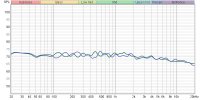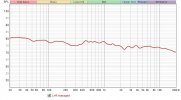KenMasters
Member
- Thread Starter
- #21
My only comment would be that the response slope seems too steep. On balance, the upper end is attenuated way too far.
You've seemed to notice that as well by your comments. I don't think anything should "stand out" in your impressions of the overall sound. If it does, it still needs work.
The response slopes down from about 4kHz (as you can see in the graph of my first attempt), in order to chase the curve I was after, I dropped all frequencies by 4dB to give me room, bumped up 1kHz by 2dB and built up (or rather down) from there.
I did feel it was a bit strong though, first I dropped the subs by 3dB but then I ended up going back in and rebalancing the upper bass through midrange anyway:

Still in the process of listening, learning and tweaking, thanks for the feedback!


